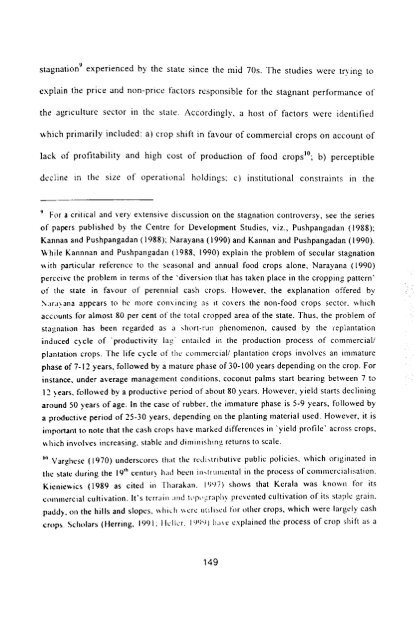economics of on-farm development - Institute for Social and ...
economics of on-farm development - Institute for Social and ...
economics of on-farm development - Institute for Social and ...
You also want an ePaper? Increase the reach of your titles
YUMPU automatically turns print PDFs into web optimized ePapers that Google loves.
stagnati<strong>on</strong> 9 experienced by the state since the mid 70s. The studies were trying to<br />
explain the price <strong>and</strong> n<strong>on</strong>-price factors resp<strong>on</strong>sible <strong>for</strong> the stagnant per<strong>for</strong>mance <str<strong>on</strong>g>of</str<strong>on</strong>g><br />
the agriculture sector in the state. Accordingly, a host <str<strong>on</strong>g>of</str<strong>on</strong>g> factors were identified<br />
which primarily included: a) crop shift in favour <str<strong>on</strong>g>of</str<strong>on</strong>g> commercial crops <strong>on</strong> account <str<strong>on</strong>g>of</str<strong>on</strong>g><br />
lack <str<strong>on</strong>g>of</str<strong>on</strong>g> pr<str<strong>on</strong>g>of</str<strong>on</strong>g>itability <strong>and</strong> high cost <str<strong>on</strong>g>of</str<strong>on</strong>g> producti<strong>on</strong> <str<strong>on</strong>g>of</str<strong>on</strong>g> food cropslO; b) perceptible<br />
decline in the size <str<strong>on</strong>g>of</str<strong>on</strong>g> operati<strong>on</strong>al holdings: c) instituti<strong>on</strong>al c<strong>on</strong>straints in the<br />
• For a critical <strong>and</strong> very extensive discussi<strong>on</strong> <strong>on</strong> the stagnati<strong>on</strong> c<strong>on</strong>troversy, see the series<br />
<str<strong>on</strong>g>of</str<strong>on</strong>g> papers published by the Centre <strong>for</strong> Development Studies, viz., Pushpangadan (1988);<br />
Kannan <strong>and</strong> Pushpangadan (1988); Narayana (1990) <strong>and</strong> Kannan <strong>and</strong> Pushpangadan (1990).<br />
While Kannnan <strong>and</strong> Pushpangadan (1988, 1990) explain the problem <str<strong>on</strong>g>of</str<strong>on</strong>g> secular stagnati<strong>on</strong><br />
"ith particular reference to the seas<strong>on</strong>al <strong>and</strong> annual food crops al<strong>on</strong>e, Narayana (1990)<br />
perceive the problem in terms <str<strong>on</strong>g>of</str<strong>on</strong>g> the 'diversi<strong>on</strong> that has taken place in the cropping pattern'<br />
<str<strong>on</strong>g>of</str<strong>on</strong>g> the state in favour <str<strong>on</strong>g>of</str<strong>on</strong>g> perennial cash crops. However, the explanati<strong>on</strong> <str<strong>on</strong>g>of</str<strong>on</strong>g>fered by<br />
:\arJ\ana appears to be more c<strong>on</strong>vincing as it covers the n<strong>on</strong>-food crops sector. which<br />
accounts <strong>for</strong> almost 80 per cent <str<strong>on</strong>g>of</str<strong>on</strong>g> the total cropped area <str<strong>on</strong>g>of</str<strong>on</strong>g> the state. Thus, the problem <str<strong>on</strong>g>of</str<strong>on</strong>g><br />
stagnati<strong>on</strong> has been regarded as a short-run phenomen<strong>on</strong>, caused by the replantati<strong>on</strong><br />
induced cycle <str<strong>on</strong>g>of</str<strong>on</strong>g> 'productivity lag" entailed in the producti<strong>on</strong> process <str<strong>on</strong>g>of</str<strong>on</strong>g> commercial!<br />
plantati<strong>on</strong> crops. The life cycle <str<strong>on</strong>g>of</str<strong>on</strong>g> the commercial! plantati<strong>on</strong> crops involves an immature<br />
phase <str<strong>on</strong>g>of</str<strong>on</strong>g> 7-12 years, followed by a mature phase <str<strong>on</strong>g>of</str<strong>on</strong>g> 30-1 00 years depending <strong>on</strong> the crop. For<br />
instance, under average management c<strong>on</strong>diti<strong>on</strong>s, coc<strong>on</strong>ut palms start bearing between 7 to<br />
12 years, followed by a productive period <str<strong>on</strong>g>of</str<strong>on</strong>g> about 80 years. However, yield starts declining<br />
around 50 years <str<strong>on</strong>g>of</str<strong>on</strong>g> age. In the case <str<strong>on</strong>g>of</str<strong>on</strong>g> rubber, the immature phase is 5-9 years, followed by<br />
a productive period <str<strong>on</strong>g>of</str<strong>on</strong>g> 25-30 years, depending <strong>on</strong> the planting material used. However, it is<br />
important to note that the cash crops have marked differences in 'yield pr<str<strong>on</strong>g>of</str<strong>on</strong>g>ile' across crops,<br />
"hich involves increasing. stable <strong>and</strong> diminishing returns to scale.<br />
10 Varghese (1970) underscores that the redi,tfloutive public policies, which originated in<br />
the state during the 19'h century had been ilhtrlllllcntal in the process <str<strong>on</strong>g>of</str<strong>on</strong>g> commercialisati<strong>on</strong>.<br />
Kicniewics (1989 as cited in Tharakan. I ')'17) shows that Kerala was known <strong>for</strong> its<br />
cOlllnll:rcial cultivati<strong>on</strong>. It's terrain ;lIld It'r,,O!raphv prevented cultivati<strong>on</strong> <str<strong>on</strong>g>of</str<strong>on</strong>g> its staple grain,<br />
paddy. <strong>on</strong> the hills <strong>and</strong> slopes, which \Vcre lIlili,cu <strong>for</strong> uther crops, which were largely cash<br />
crop .. Scholars (Herring, 1991: lie I kr, 1'1')'1) 11;1\ C explained the process <str<strong>on</strong>g>of</str<strong>on</strong>g> crop shi ft as a<br />
149
















